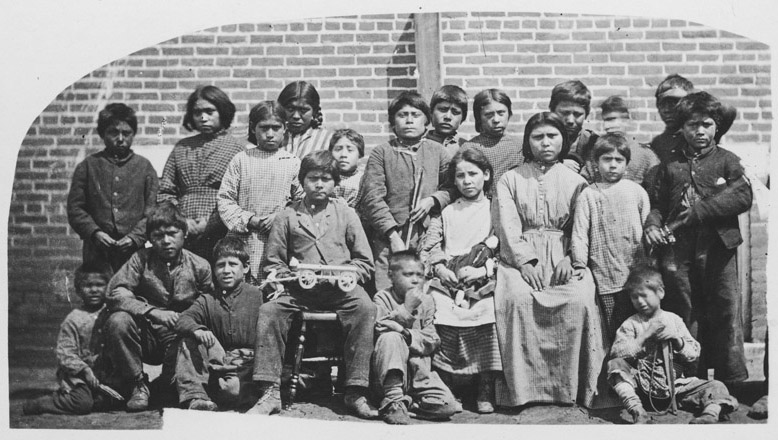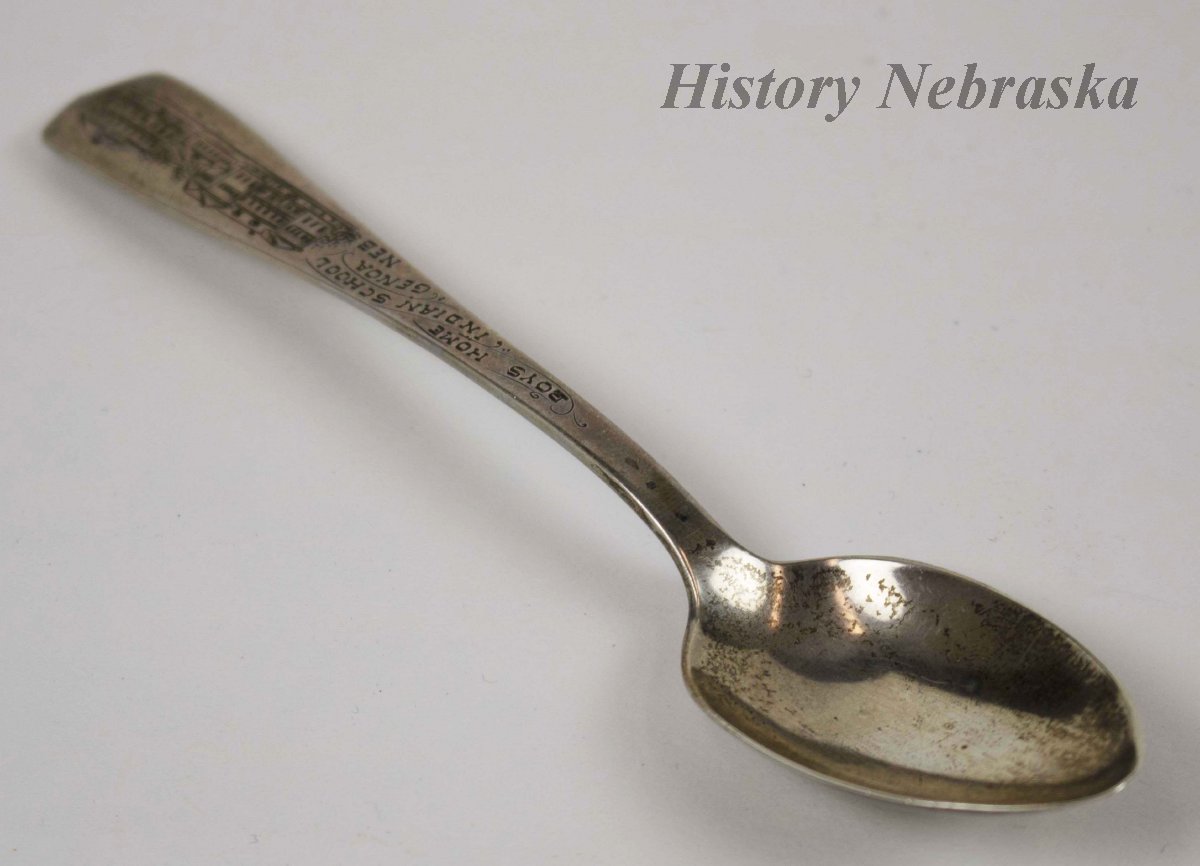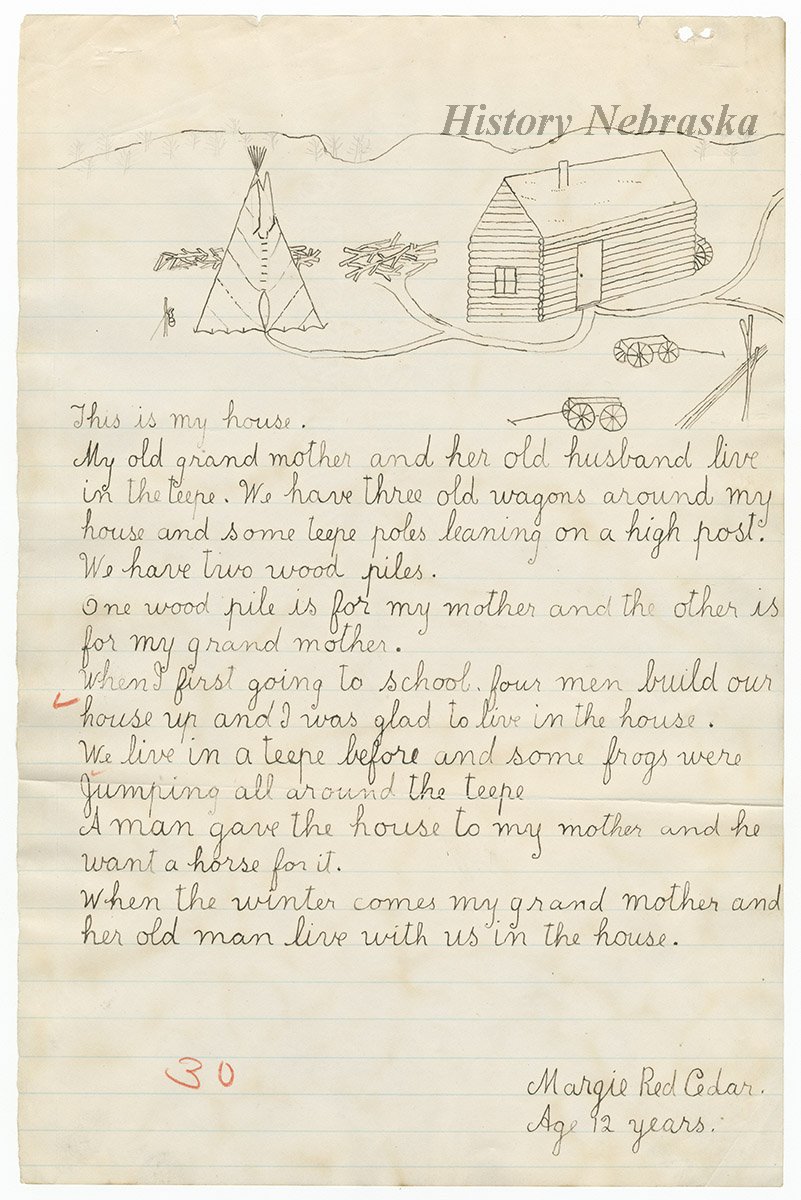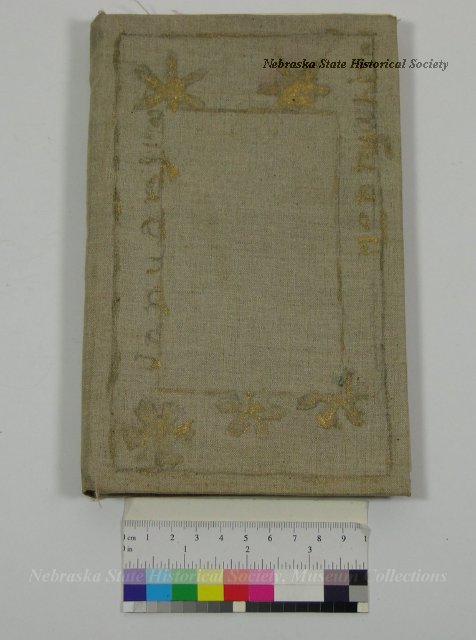
Photo: Pawnee children at their reservation boarding school in Nance County, Nebraska, circa 1871
By Araceli Hernandez, Digital Outreach Educator; David Bristow, Editor; and Jessica Stoner, Education Associate
Updates to this story:
July 21, 2023: Associated Press, “No children’s remains found in Nebraska dig near Native American boarding school.” Nebraska State Archeologist Dave Williams will meet with representatives of 40 tribes to determine next steps.
June 22, 2022: Australia’s ABC News has produced a 30-minute video about the search for graves at Genoa. It features members of the Santee and Omaha tribes, Nebraska State Archeologist Rob Bozell, Nebraska Commission of Indian Affairs Director Judi gaiashkibos, and others, plus archival filmed interviews with former students. Historic photos and present-day footage show the challenge of locating graves. Watch it here and read an accompanying article.
May 30, 2022: A team of trained search-and-recovery dogs have identified a possible location of the Genoa Indian Industrial School cemetery. Read more in the Omaha World-Herald.
May 17, 2022: An article in the Spring 2022 issue of Nebraska History Magazine discusses the early years of Genoa Industrial Indian School. Read about it here. Also, a new report from the US Interior Department details the brutality of federal Indian boarding schools.
Nov. 17, 2021: Researchers have uncovered the names of 102 Native American students who died at the U.S. Industrial Indian School at Genoa, Nebraska. The State Archeology Office (part of History Nebraska) has been using ground-penetrating radar at some possible locations of the school’s cemetery, thus far with negative results. This work is being done at the request of the Nebraska Indian Commission. The investigation is being led by the Genoa Indian School Digital Reconciliation Project. This is a developing story. Read more here (Associated Press).
August 2, 2021
History Nebraska employees were deeply saddened by the recent discoveries of Indigenous children’s remains at residential schools in Canada. We cannot imagine the hurt that has long been experienced by the affected families, relatives, and communities. In the words of Canadian Prime Minister Justin Trudeau, the unmarked graves “reaffirm truth that they have long known.” Our thoughts are with them.
As a historical institution, we acknowledge the harm and lasting negative impact that such institutions have had on Indigenous communities, not only in Canada but also across the United States.
Nebraska has its own ugly past with “Indian Schools.” While there is much work yet to be done, here are links to some materials that we hope will shine a light on systemic racism, discrimination, and marginalization experienced by Indigenous communities.
The U.S. Industrial Indian School in Genoa
In an effort to assimilate Indian children into white society, non-reservation boarding schools were built. These schools were located far from reservations to reduce contact between the children and their parents and Indian customs. Genoa, Nebraska, was selected as a school site because the government already owned the building previously used for the Pawnee reservation headquarters. Most of the children in the Genoa school made friends, adjusted to harsh conditions, and learned the art of showing a “white” veneer to get through their school years. But they paid a high price for their education in terms of their physical and emotional health. They were separated from their families and there was not enough money to adequately feed, clothe, and educate them. Full assimilation of the Indian children into white society did not occur and the schools began to close in 1901. Genoa school closed in 1934.
Grace Stenberg Parsons, “The Indians as I Knew Them – Memories of the Genoa Indian School“
As the daughter of the blacksmithing instructor at the Genoa Indian School in Genoa, Nebraska, Parsons observed the young Native American children who attended the school on a daily basis from 1907-1911. This short memoir of her experiences gives details about her childhood growing up on the Crow Reservation in Montana and living at the Genoa Indian School in Nebraska. Although her narrative is written from a White perspective that reflects some of the attitudes of her time, she provides a vivid account of conditions at the school. The original manuscript can be found in History Nebraska’s collections: RG1298.AM.
Genoa Indian School Digital Reconciliation Project
The Genoa Indian School Digital Reconciliation Project is a collaboration between the University of Nebraska-Lincoln; the Genoa U.S. Indian School Foundation; Community Advisors from the Omaha, Pawnee, Ponca, Santee Sioux, and Winnebago tribes of Nebraska; and descendants of those who attended Genoa. This website provides many primary source materials about various aspect of the school and its students.
To learn more about Nebraska’s Indian Schools
Below are resources for researchers who may be working on school projects, scholarly research, or just people who are curious to see what artifacts and documents still exist.
What we know about these artifacts and documents varies in breadth and depth. The details we have are in the links. Most items need more research and, ideally, the perspective of the cultural leaders of the relevant tribes, because historical writing and museum collections tend to reflect the priorities and perspectives of the dominant society.
Other Genoa Indian School items from History Nebraska Collections

Roster, Genoa Indian School 1933-1934 (4298-4-(1))

Spoon, Souvenir; Boys Home, Indian School, Genoa, NE (11055-2558)
Other Indigenous Boarding Schools in Nebraska
Manuscript collections (historical documents paper, but not digitized yet): These links to finding aid (sort of a table of contents for the collection) explains what’s in the collection. As these items are not yet digitized, you can check them out by visiting the Reference Room of the History Nebraska Library/Archives in-person on Fridays, between 9:00am-4:00pm. History Nebraska’s Reference Room
- Eunice Stabler, 1885-1963, Omaha tribe, attended Genoa Indian School [RG 2585.AM] History Nebraska – Manuscript collection
- James Henry Red Cloud, 1879-1960 [RG1355.AM] | History Nebraska – Manuscript collection
- Presbyterian Board of Foreign Missions [RG2683.AM] Omaha Mission School correspondence.
- Santee Normal Training School (Santee, Neb.) [RG2497.AM]
Artifacts:

Margie Red Cedar, 1902 essay and drawing, Pine Ridge Agency Day School (7294-3734).

Book, Diary/Notebook, From Indian School, 1902 (11055-2912)
Annual U.S. Department of the Interior reports
These reports detail Agency Indian Schools of Nebraska.
Tribal Documents Archive | Page 30 – While told from the perspective of the non-Native, Indian agent, these links to annual Superintendent reports can provide some insight into facilities and structure of these schools. To use, click on the year you’d like to read about, and then scroll down to the table of contents (pp.3-4 of PDF for 1877), (pp. 34-36 of PDF for 1866). Then look for the tribe you’d like to read about. The tribe might listed by state or if during territorial times, by region.
.



